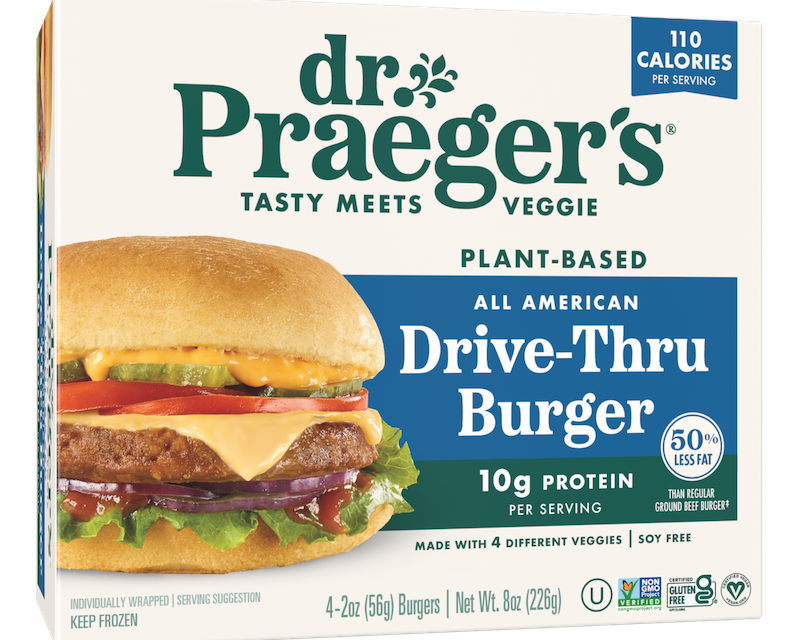As part of a rebrand, Dr. Praeger’s is focusing on vegetables

Plant-based foods brand Dr. Praeger’s is celebrating its third decade in business with a complete brand refresh.
Starting this quarter and next quarter, Dr. Praeger’s — whose hero products include veggie burgers, veggie fries and veggie “Littles” — will swap its logo from a black font to a green font with a veggie icon beside it. Its tagline will change from “Purely Sensible Foods” to “Tasty Meets Veggie,” and its website will boast a sleeker, more modern look.
Dr. Praeger’s brand revamp comes at a challenging time for the plant-based meat alternatives space. The category exploded shortly before the pandemic as consumers tried out brands like Beyond Meat and Impossible Foods. However, interest has since dipped; sales of the category in U.S. retail stores fell nearly 20% from July 2022 to July 2023, according to Circana.
Still, Dr. Praeger’s said it has managed to hang onto sales as a beneficiary of the “better-for-you” boom, which emphasizes clean, health-forward ingredients. Its rebrand leans into this, and it hopes that by focusing on quality and taste, it can bring in new customers.
“We’re really proud of great-tasting veggies, and so we’re leading with that,” Steve Polonowski, chief customer officer at Dr. Praeger’s, told Modern Retail. “When you look at the graphics of our food, we’re just trying to take that next step. We’ve always taken pride in how great our food looks when it’s prepared, and we’ve tried to up that bar even further with this latest rebrand.”
Dr. Praeger’s started on the revamp about a year ago and plans to slowly roll out each element over the coming months. A new website, which Dr. Praeger’s wants to launch shortly, will highlight some of its newest products, like the Crunchy Burger, as well as high-growth categories like snacks and its Littles products, which come in shapes like dinosaurs and stars. Sales of Littles are up some 20% year-over-year and have a five-year compound annual growth rate of 36%, according to the company.
When Dr. Praeger’s began in 1994, it focused on building awareness organically, Larry Praeger, special advisor & board member at Dr. Praeger’s, told Modern Retail. Around 2013, the business accelerated as veggie burgers became more commonplace. “We probably grew the company by seven times until Covid, roughly,” he said. The brand saw a “big spike” during the pandemic as more people spent time cooking and eating at home, Praeger added.
Ad position: web_incontent_pos1
The last two years or so, Dr. Praeger’s has worked to maintain momentum by focusing on its kids’ business, trying out new textures and flavors — “variety is really what sets us apart,” Praeger said — and restocking its most popular products on shelves. Today, the brand can be found at retailers including Whole Foods, Target and Walmart, as well as via Uber Eats and Instacart.
Why it rebranded
It’s not uncommon for grocery brands to refresh their logos and product offerings to change their messaging, reflect a new direction or keep up with competitors. Instacart, for example, unveiled a redesign in 2022 with new typography and colors like “kale green” and “guava pink,” Grocery Dive reported. Whole Foods rebranded its 365 private label line in 2020, and Snapple changed the name of Diet Snapple to Snapple Zero in 2022.
When it comes to a rebrand in grocery in 2024, “taste and value cannot be understated,” Blake Droesch, senior retail and e-commerce analyst at Insider Intelligence, told Modern Retail. Many consumers are cutting back on purchases due to inflation, he explained, and others are switching from brand-name goods to private-label ones to save money. “If a rebranding can communicate that these are not only healthier options, but also affordable options, that is definitely crucial,” Droesch added.
One of the challenges with this type of rebrand, however, is that “grocery buying is very habitual,” Droesch said. “If someone is exploring a plant-based diet and is not satisfied with the options that they try initially, it’s hard to get them to come back and keep trying new options.”
Ad position: web_incontent_pos2
“It’s definitely not a sure thing that you can slap a new label on a box, say it’s a new product line and have that be automatically successful,” Droesch added. “But, it can definitely steer consumers in the right direction.”
Today, more plant-based companies are playing up how many vegetables they use. In fact, Whole Foods predicts that this year, brands will “put the ‘plant’ back in plant-based” by using products like mushrooms, tempeh and legumes. Unlike meat-imitation companies, Dr. Praeger’s main goal as a brand is to get people to eat veggies. “Doing demos and actually getting people to try the product, it’s amazing how many people are shocked how great it tastes and how convenient it can be to eat,” Praeger said.
Ultimately, Dr. Praeger’s is confident that its rebrand will be successful and that the brand will find new fans. “We’ve seen in our own portfolio over 30 years what works and what doesn’t,” Polonowski said. “We take the winners, and we run with them. Despite a lot of the headlines that you read around plant-based… as we look at 2024, we’re expecting good growth this year.”

